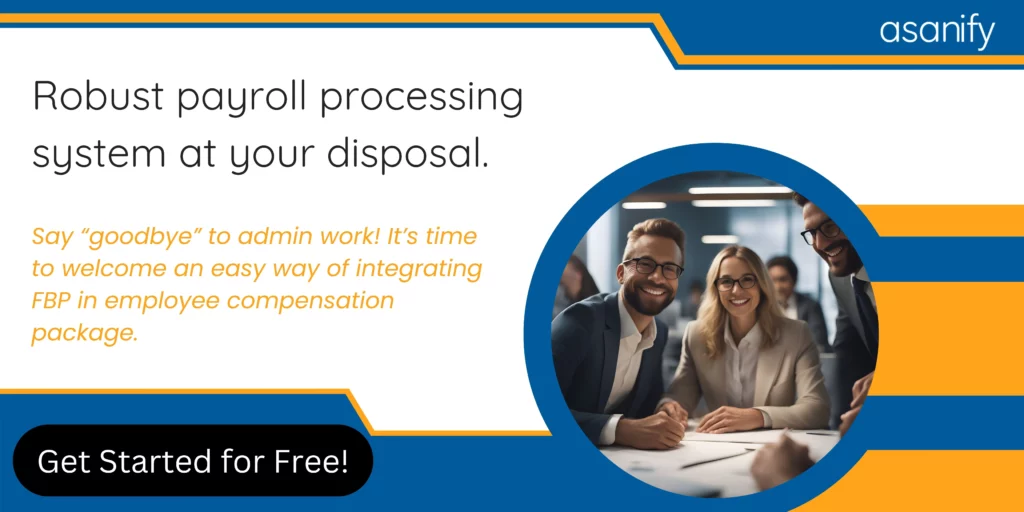Flexible Benefits Plan (FBP) allows employees to choose the benefits they want or need from a package of programs offered by an employer. It’s the part of the salary that gives liberty to employees to modify the components of their CTC (Cost to the company). FBP allows the employees to have better control over their plans and hence better control over their lives. They can decide which components of the CTC they want to opt into and how much each component. Flexible employee benefit plans may include health insurance, retirement benefits, conveyance, phone bills, etc according to the company and its employees’ requirements.
The relationship between employer and employee is always mutually beneficial. Understanding that every employee is different and hence they have different requirements is a necessity today. Catering to the needs of employees is one of the most important aspects of both small and large businesses. Hence, having a good flexible benefits plan can help a business attract and retain top talent. Now that we know the answer to what is FBP, let’s swim deeper into its various aspects!
Table of Contents
- What are the components of FBP?
- What is FBP Declaration?
- How to Declare Flexible Benefits Plan in Salary?
- Types of Policies for Flexible Benefits Plan
- How Flexible Benefits Plan Fit into CTC?
- How Can You Save Tax on Your Salary?
- What are the Benefits of the Flexible Benefits Plan?
- Drawbacks of Flexible Benefits Plan
- Challenges Lying Ahead in the Way of Implementing Policies of FBP
- Frequently Asked Questions- Flexible Benefits Plan
What are the components of FBP?
- HRA – House Rent Allowance is a part of most companies’ Flexible Benefits Plan. The employee can claim HRA only if they are living in a rented house. It means that the salaried component received towards rent payment is allowed as a deduction from taxable salary.
- Conveyance – This may include vehicle lease, fuel bills, chauffeur service, and cab costs. An employee may opt-in for this if their commute to work takes up significant time and cost every day. A lot of employees travel for client meetings or have a lot of fieldwork that requires traveling within or outside the home city. So, the conveyance component may cover different concepts according to the requirements of the company.
- Phone bills – Nowadays, most of the work is done by phone and the internet. Most companies include postpaid mobile service bills and broadband connection bills as part of the flexible benefits plan in the salary.
- Food Bills – In fields where the employees need to travel a lot for work, it’s common for companies to have meal or cafeteria bills under their flexible benefits plan.
- Medical Bills – Health insurance are a way to cover a lot of medical bills. Different companies provide different health insurance plans for their employees and sometimes for their dependents as well. These may include life, dental, vision, and mental health insurance.
Suggested Read: Types of Employment Contracts
What is FBP Declaration?
FBP declaration is nothing but employees declaring the flexi components that they want to incorporate into their CTC structure. Declaring the flexible benefit components is essential to reduce tax burdens. This is because some allowances are tax-exempt. As a result, FBP declaration helps employees in saving taxes during the Income Tax filing season.
Either the company leadership or the HR department needs to go ahead with asking employees about their flexi component choices. They can do so by using a HRMS platform, or an employee survey.
How to Declare Flexible Benefits Plan in Salary?
Declaring FBP allowance in salary can be easily done by following these steps:
1. Select Benefits
The first step to declaring FBP in your salary is to select the benefits you want to include as FBP components. The benefits may be anything, starting from House Rent Allowance or HRA, medical allowance, conveyance allowance to phone allowance.
2. Ascertain Individual Amounts for the Chosen Components
Once you are done with the selection of benefits, decide the amounts that you wish to keep aside for each component in the FBP allowance. Do note that, in certain cases, the amount that you wish to allocate for each component, will vary- subject to certain eligibility criteria.
3. Share Details of Chosen Flexible Components in Salary
Now is the time to inform the employer or HR Head about the FBP components that you have chosen. Further, make sure that you are informing them about the respective amounts you have allocated for each components.
4. Document Submission
To support the flexible benefits you have selected, you may have to submit some documents that would act as proofs. Say, you have opted for medical insurance. In that case, you would have to share with the employer medical bills. Or, if you choose HRA, you have to submit some form of document that would serve as house rent bills. The same goes with conveyance, phone, and other benefits that you choose. An accompanying document is a must for every chosen flexi benefit.
5. Updating the Payroll
After you are done communicating your benefits choice, your employer will now add these FBP components into your salary structure. Further, necessary changes will also be made in the calculation process while running payroll.
6. Checking the Taxing Component
Depending upon the flexi components you choose, the taxing regulations will fluctuate. This is because, some benefits are liable to tax deductions. Contrarily, some FBP components are exempted from being taxed. We’ve prepared a table below highlighting the ways you can save tax on your salary.
Recent reports suggest that the adoption rate of FBP among employees has increased at a staggering rate.
Types of Policies for Flexible Benefits Plan
Let’s take a look at the types of policies concerning Flexible Benefit Plan!
1. Mutual Exclusion Policy
In this policy type, both the employer and the employee come together to discuss and take mutual decisions on the components that are to be excluded from the FBP allowance.
2. Opt-in Policy
Under this type of policy, employers brand the flexible components as “opt-in.” This means that employees don’t get to modify the component. After all, the employer has already categorized that part to be a fixed pay.
3. Quantity-based Policy
This type of policy holds sway over all flexible components whose particular base value the employer has already declared. Employees get the chance to select the component quantity on the basis of the base value.
4. Dependent Policy
As you can make out from its name, one component of the FBP allowance is announced as being dependent on another component. Therefore, when employees move ahead with the FBP declaration, they need to do it for both the components at the same time.
How Flexible Benefits Plan Fit into CTC?
In case you were wondering how FBP was fitting into the picture of CTC, here is a detailed breakdown of the same.
|
Category |
Component of CTC |
Amount |
|
Basic Salary |
Basic Salary | Comprises 40 to 60% of the CTC |
|
Flexible Benefit Allowances |
House Rent Allowance | Varies depending on the basic pay |
| Conveyance Allowance | Fixed | |
| Travel Allowance | Fixed | |
| Children’s Education Allowance | Fixed | |
| Medical Allowance | Fixed | |
| Fixed Allowance | Fixed | |
| Overtime Allowance | Variable | |
|
Benefits |
Provident Fund | 12% of PF amount |
Recommended Read: Salary Structure in India- The Ultimate Expert Guide
How Can You Save Tax on Your Salary?
Provision of FBP allowance can help employees save up to Rs 60,000. That’s a really captivating hook attached to Flexible Benefits Plan! Moreover, both the parties- employers and employees get to benefit hugely from the Flexible Benefits Plan. While employees get the chance to save substantial amounts of money, employers use this plan to create a employee-centric work culture.
|
Components |
Monthly | Annually |
Remarks |
| House Rent Allowance (HRA) | 25,000 | 3,00,000 | It is tax-exempted, but partially so. |
| Leave Travel Allowance | – | 1,50,000 | Tax-exempt upon the submission of bills |
| Telecom (includes mobile recharge and internet charges) | 3,000 | 36,000 | Tax-exempt when bills are submitted |
| Fuel Allowance | 2,400 | 28,800 | Tax-exemption possible upon submission of bills |
| Children’s allowance (education and hostel allowances) | 800 | 9,600 | 400 per month for two children |
| Food Allowance | 2,200 | 26,400 | Tax-free till the limit of Rs 50 per meal (basis- 22 working days) |
| Academic Development | – | 2,00,000 | Tax-free upon the submission of bills |
| Books Allowance | 1,000 | 12,000 | Tax-free when bills are submitted properly |
| Driver Salary Allowance | 3,000 | 36,000 | Tax-exempt upon bill submission |
| Uniform Allowance | 1,000 | 12,000 | Tax-exempt upon the submission of bills |
| Gift Voucher | 5,000 | – | Tax-free till a limit of Rs 5,000 |
Employees have the liberty to choose any FBP components they prefer to include in their salary structure. Based on the respective income slabs, employees get the lucrative chance to save taxes up to 30%.
Suggested Read: Navigate the Latest Tax Slabs Changes in the 2023-24 Budget
What are the benefits of the Flexible Benefits Plan?
For Employees
1. Less financial stress
Worrying about when the money will arrive to pay bills or purchase necessities can be stressful for employees when supporting and providing for a family, so having an FBP can help them meet their needs and alleviates a large amount of stress.
2. Tax Saving
The components of the flexible benefits plan like food bills, phone bills, HRA, and travel allowance are not taxable. Including these components can help reduce tax significantly as it is calculated on the basic salary. This means that they will be saving money from their taxes in each paycheque.
3. Control of benefits and expenses
An FBP allows employees not just to choose the components but also the amount spent on each component. A traditional benefits plan does not allow for this type of choice. That leads to most employees paying a great amount more than they need.
4. Effective recruitment
Every business needs to find a way to stand out to potential employees. Recruiters should also encourage prospects to join the business. Offering benefits is sure to attract good talent when they are comparing incentives and salaries among the companies. This allows them to have more control over the issues that they have in their lives.
5. Employee retention
Executing a good benefits plan displays a company’s employee-friendly work culture and makes the employee feel valued, hence preventing attrition. Employees are less likely to resign when they have their needs met in a practical way without much effort on their part.
6. Transparency and Productivity
By offering a flexible benefits plan, the company can offer transparency by giving the employee a complete breakdown of the perks or incentives on offer. An adequate range of choices in FBP can keep the employees satisfied and happy, leading to increased productivity.
7. Financial Control
FBP helps in planning annual budgets as it allows the employer to set a spending limit for each month or year. With the knowledge of the employee benefit plan, the company can know the expected expense for every year and make their budget accordingly. These benefits are tax-deductible and are a win-win.
For Employers
1. Increased Chances of Hiring Amazing Talent
Research studies reveal that flexible benefit plans have resulted in greater job satisfaction among employees. As a result, companies offering flexible allowance have a greater chance of luring remarkable talents to work for them. Including flexi components in salary structure translates into the fact that the company is desirous of taking care of an employee’s financial well-being. Since it strikes a chord with the employees, they prefer to stay in those companies for a long time span. Consequently, employers experience enhanced recruitment and retention rates.
2. Stimulates Employee Retention Rate
When employers start offering the flexi benefit plan, employees automatically perceive the organization to be a people-centric one. Further, this element of flexibility in the benefits package drives a sense of happiness and satisfaction into employees’ minds. As a consequence, flexible benefit plan gives a fillip to employee retention rate. With a spurt in employee morale, the need to look for better opportunities in other firms diminishes to some extent. Thus, the employee retention rate in these companies increases at a lightning pace.
3. Multiplies Productivity
The provision of FBP allowance in a company signals the presence of happy and satisfied employees. No wonder that, it will lead to the creation of a healthy and positive work culture in an organization. This, in turn, will boost employee productivity in a company. Therefore, employers can also stay stress-free on knowing that their company houses a productive workforce.
Drawbacks of Flexible Benefits Plan
For Employees
1. Potential to lose money
When an employee sets out a certain amount of money for a particular component, there’s always the risk of losing that money if they don’t utilize it over a period of time. Some flex plans do not allow employees to save money if they do not spend it over the year. Although this is a major disadvantage, having the ability to prepare for a worst-case scenario is still advantageous, especially considering that some plans will include life and dental, and/or vision insurance.
2. Lack of portability
Normally health plans are portable, but flexible benefit plans are not portable or transferable to a new company. This may lead to employees staying in a job simply because of their benefits, and not because they are happy there. A company should make sure that its employees are satisfied not just with their benefit plans but also with their work environment.
3. Knowledge of the plans
It is important that employees stay informed about a company’s FBP. Without complete knowledge of the plans, they might not be able to make an informed choice. It may lead to choosing plans that do not suit their requirements and they might not get the benefits they otherwise can.
4. Reimbursement
Sometimes employees need to pay upfront for the services they use and get the reimbursement later. This can be a tiresome and long process if the company’s reimbursement process is slow and ineffective. A company should have a good expense policy in place to make sure reimbursement is not an obtuse process.
5. Setup costs
Setting up a new benefit plan is time taking and costly. It needs, designing and implementing according to the needs of individual employees. This does not add value to the company and can be too time-consuming. This also requires a lot of new technology to keep track of the plan.
6. Change
Moving from a traditional benefits plan to a flexible one can be a long process. It is difficult in terms of time and money, but also in terms of acceptance. The already existing employees might have a strenuous time understanding the different aspects of a flex plan. It is necessary for the company to educate them and let them know about the different components of the plan.
7. Updated Technology
The company might need to update its technology to use and track the usage of the plan to prevent any misuse or error in budgeting.
8. Misuse
Making sure that the bills uploaded or claims made are justified and not forged can be a tedious job as well. Providing employees with a great flexible benefits plan is essential, but it’s also essential to make sure that they are not misusing the benefits given to them so that the company does not face any kind of loss.
For Employers
1. Cumbersome Implementation Process
Employers get trapped in the whirlwind of spending significant amounts of time and money while executing the Flexible Benefits Plan. Further, if this is something that the company didn’t have since its inception and is introducing it for the first time, employees also take their own sweet time to understand about this new plan. Companies need to ensure that they are taking out sufficient time to make their employees aware of the Flexible Benefits Plan. Moreover, employers need to ensure that they are addressing employee queries with due care. Any sort of misunderstanding among employees with regards to FBP allowance may impair all the efforts of the employer in bringing in these flexi benefits.
2. Heavy Expenditure on Initial Setup Process
As we mentioned before, adopting Flexible Benefits Plan all of a sudden may turn out to be a costly affair for company owners. Switching to a flexi allowance system entails a lengthy procedure of not only administering new changes but also hefty expenditures. It is recommended that companies resort to advanced technologies to make this transition to a new benefits program seamless and less cost-intensive.
With increasing competition, companies need to stay ahead in terms of their incentives and benefits along with the compensation offered. As the workplace becomes more diverse, so too do the needs of employees, and it’s important to maintain a happy work environment where the employees are excited to go to work. Having a good flexible benefits plan is mutually beneficial to the employee and employer. This being said, companies should make sure they conduct proper research on their employees and consider all the pros and cons before they implement a flexible benefits plan.
Challenges Lying Ahead in the Way of Implementing Policies of FBP
The huge number of administrative procedures involved in switching to Flexible Benefit Plans may baffle employers. Further, lots of hard work is involved in this transitioning activity. The following challenges might turn out to be a true nightmare for company owners:
- Companies relying on traditional payroll processing methods and not having Employee Self-Service (ESS) portals or automated HR Management Software may have a hard time in streamlining the FBP declarations. Embracing an efficient payroll generation and HRMS tool will aid you in switching to FBP quite smoothly, without facing any hassles. In that way, proper communication between the HR department and employees will be maintained. Therefore, ensuring proper communication between both the parties is way too crucial, especially, when a new plan is being implemented.
- Incorporating FBP into employee salary implies welcoming a change in the way payroll calculations are done. If calculations are done manually, it is obvious that the process will not only get tedious but also erroneous. Configuring the new changes in the payroll settings can be easily done by using an online payroll software. By using this, all the heavy lifting of modifying the calculations will be robbed of your shoulders.
Frequently Asked Questions- Flexible Benefits Plan
What is a flexible benefits plan in CTC?
Flexible Benefit Plan in India, based on the benefits like medical insurance and conveyance mentioned in the offer, helps employees to modify and structure their CTC components.
What are the advantages and disadvantages of a flexible benefits plan?
Having a flexible benefit plan helps improve HR Excellence. The advantages of offering flexible benefits are:
- It helps with employee retention
- Attracts talented new recruits who give benefits and perks very high importance.
- Provides employees control over their benefits
- Lets employees choose the right benefits for themselves.
There are a few disadvantages as well, like offering flexible benefits to employees requires administrative resources and time. It can be very expensive as the company may have to license a new technology for implementing this. Further, it also requires exceptional communication, as employers need to be up to date regarding the benefits and communicating it to employees.
What is a major disadvantage of flexible benefit plans?
The main disadvantage of some flex plans is that employees put in a certain amount of their savings each month, if they do not use the benefits, there are chances that they won’t be able to recoup the money.
Is FBP deducted from salary?
A Flexible Benefits Plan (FBP) is part of an employee’s salary, which gives more control over CTC components that they want to opt-in for. This way employees can significantly reduce their tax liabilities.
What is the use of a flexible benefits plan in salary?
A Flexible Benefits Plan (FBP) helps employees in modifying CTC components such as transportation and medical expenses.
Is a Flexible Benefits Plan Taxable?
ITR specifies that certain allowances given to employees, which are attributed to business needs are exempted from income tax. These are also known as Flexi Benefit Allowances.
Is Flexible Benefit Plan paid monthly?
The HR Department pays certain flexible components such as HRA and vehicle lease monthly. Further, there are some annual flexi components as well. For instance, fuel, book bills, etc. fall under the ambit of annual component. So, these amounts are disbursed annually.
What is FBP in salary slip?
A Flexible Benefit Plan or FBP is a part of an employee’s salary over which an employee gets the chance to wield their decisions. They can select certain components that they want to incorporate into their package, and also the allocated amount for each component.
What is FBP Eligibility?
FBP eligibility criteria is very simple. In India, every full-time employee working for 20 hours or more in a week deserves to get access to the FBP allowance.
Not to be considered as tax, legal, financial or HR advice. Regulations change over time so please consult a lawyer, accountant or Labour Law expert for specific guidance.








